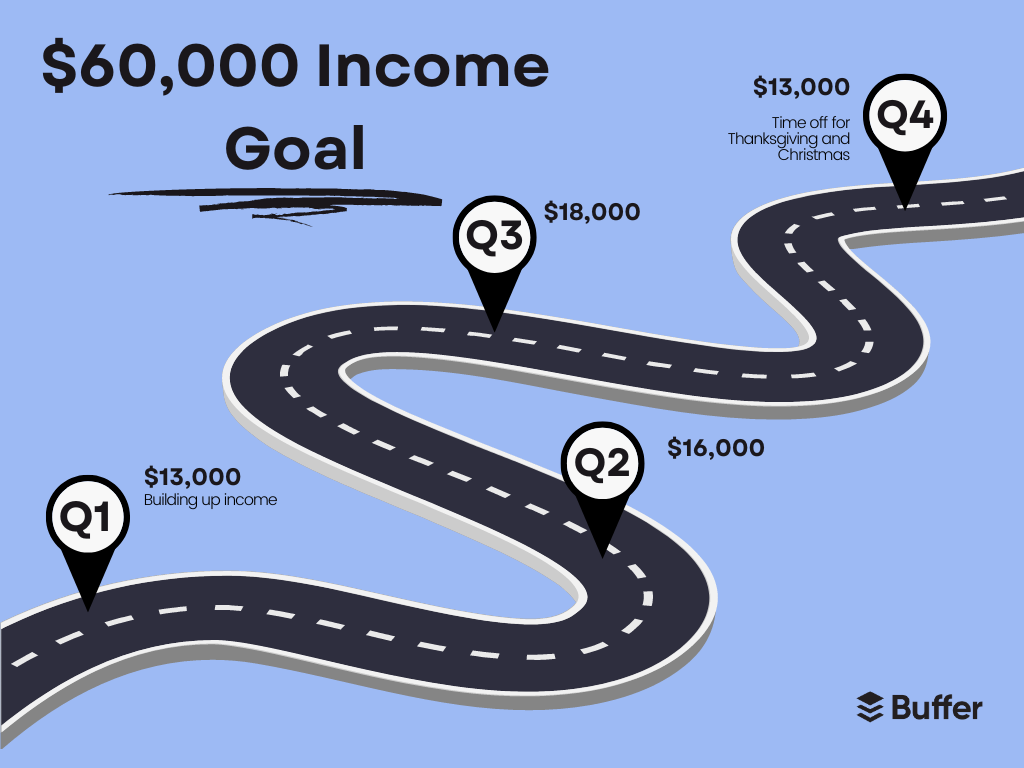Are you a freelancer looking to grow your income? It can be tough to know where to start. Perhaps you’ve fallen into comfortable freelancing routines with clients you’ve been working with for months or years.
That kind of stability is great … but it can also keep you trapped. Maybe you’ve stopped questioning your assumptions about how long writing an article will take, for instance, or you haven’t raised your rates in ages because you’re worried about losing a client.
I’m going to take you through the strategies I used to increase my freelance income from one year to the next. This isn’t a story about “how to 10x your income” or “how I went from rags to riches overnight,” … but instead, I hope, a more realistic and achievable look at how to significantly increase your own freelancing (or small business) income.
Let’s start with the end in mind: these strategies led me to go from approximately $39,200 USD [£30,744] to approximately $70,500 USD [£55,266] in a single year. That’s a 79 percent increase. I did this around a normal, everyday life, with a spouse, kids, hobbies, and many other things I didn’t want to compromise.
Here’s what I did … and how you can do the same, whether you’re just getting started or you’ve been freelancing for years.
Step 1. Set Clear, Specific Income Goals
I’ve been freelancing for over 16 years now, and I’m embarrassed to admit that for far too many years, I didn’t have a particular income goal in mind. I was covering all my bills, and in general, I was happy to simply make the same amount I’d been making in my day job when I was in my early 20s.
Much later, I realized this is a common problem for freelancers and solopreneurs when I came across this piece by Naomi Dunford of Ittybiz. She explained:
If you can’t seem to break a certain number (and especially if that number is suspiciously close to your old day job salary), you’ve got an upper limit problem.
How to Do It
Figure out what you made last year (last calendar year or previous tax year, whatever makes sense for you). Then, set a higher goal for the coming year. Aim for something challenging but realistic: maybe a 25 percent or 50 percent increase, or even 100 percent more, if you’re going to be able to work more hours.
Let’s say you made $30,000 last year. You could aim for $45,000 this year. It’s a significant increase, but far from an impossible one.
Note: Personally, I set income goals for the calendar year, but for the purposes of this post, I’ve given my income increase here based on tax years (for me in the UK, that’s April 6, 2021–April 5, 2022, vs. April 6, 2022–April 5, 2023) as that’s how my detailed records work out.
Step 2. Know What WON’T Work for You
In my business, I could potentially make more money by subcontracting: plenty of freelancers do, and this is how Kat Boogaard achieved some incredibly impressive figures as a freelance writer, scaling her business to make over $300,000.
But for me, right now, I like the simplicity of being a one-person business. My husband works away some of the time and has much less flexibility than me: I really like being able to plan my work around just me, taking time off for our kids as needed.
There are plenty of ways I could increase my freelance writing income … but those aren’t trade-offs I’m willing to make at this point in my life. Back before I had kids, for instance, I was happy to work on weekends; now, I avoid evening and weekend work.
How to Do It
Decide what your own “lines in the sand” are with your freelancing. Perhaps you want to keep weekends (or at least one weekend day) completely free from work. Maybe there are certain types of freelancing work you won’t take on – I know freelancers who won’t write pieces about guns, say, or tobacco.
There are plenty of ways to make more money within the boundaries that are healthy for your business and for you as a person.
Step 3. Break Down Your Annual Income Goal Into Smaller Chunks
Once you’ve got your income goal, you’ll need to break it down into smaller chunks so that you can figure out if you’re on track or not at any given time.
When I first started doing this, I used to split up my goal purely mathematically. If I wanted to make, say, £40,000 in a year and wanted to work 40 weeks (kids are in school for 38 weeks of the year in the UK), then that would mean earning £1,000 per week. But it soon became clear that not all weeks would be exactly the same.
Now, I tend to break down my goal by quarter, then month, then week. So, for instance, in the first quarter of 2024, I knew I’d have less freelancing work than usual, so I set a lower goal for Q1 vs Q2.
How to Do It
In general, plan to make a bit less in the first few weeks or months of the year. You’ll gradually bill more as you bring on new clients, raise your rates, or get better at using your freelancing hours efficiently.
Think about times of the year when you’re likely to have vacation, family commitments, or other responsibilities affecting your freelancing time. For example, the final quarter ends on Dec 11th, as it's my birthday on Dec 12th, and I like to keep work to a minimum for the rest of the calendar year.
Here’s how your year might break down for a $60,000 income goal:
- Q1 (Jan-Mar): $13,000 (building up income)
- Q2 (Apr-Jun): $16,000
- Q3 (Jul-Sep): $18,000
- Q4 (Oct-Dec): $13,000 (time off for Thanksgiving and Christmas)

You can then break down this goal by month, by week, and by day. You don’t need to set this all out at the start of the year (in fact, I recommend you don’t!) Instead, see what’s coming up week by week and plan accordingly.
Step 4. Track All Your Freelancing Time
I got serious about tracking my time during 2022 – and this is the one change that I believe made the biggest difference to my income that year.
Tracking my time showed me:
- Some of my work was netting me close to $200/hour. Other work was bringing in more like $120/hour. Knowing that made it easy to know which client’s work to prioritize.
- Some tasks took longer than I thought they did (like preparing invoices). Before tracking, I often mentally discounted this kind of admin time, forgetting to really plan for it in my week.
- I worked fewer hours than I thought, usually just 15-20 hours per week.
The act of tracking my time encouraged me to focus on billable tasks, like completing articles for clients, rather than non-billable work, like writing emails. This paid off really well in terms of my income in the medium term, though now, in 2024, I’m adding in more time on marketing and networking again so I can continue to grow my business.
How to Do It
There are loads of different apps to help you track your time. Having experimented with a few, I find that Clockify is the best fit for me.
If you don’t want to use an app, you might like to try tracking your time using a spreadsheet in 15- or 30-minute intervals.
Step 5. Ringfence Your Working Hours
I’m sure I’m not the only freelancer who finds that when you’re working from home, and you don’t have set hours (or a boss), it’s very easy for all sorts of non-work tasks to creep into your day.
Whether it’s popping to the store for a missing ingredient for dinner, switching the laundry to the dryer, or chatting to a friend on the phone, you might find that your working time is getting interrupted or chopped up.
Some flexibility is no bad thing; in fact, it might well be why you chose to freelance in the first place. But flexibility can become a problem if you’re constantly adding just one more thing into your day … meaning that you’re losing hours of productive time over the course of a week.
How to Do It
You might find that it helps to:
- Have specific “start” and “stop” times for your freelance day. (My day is book-ended by my kids’ start and end times at school.)
- Have time allocated elsewhere for non-work admin and chores, so these don’t end up creeping into your work day.
- Keep your work to-dos and your life to-dos in separate to-do lists. That could mean two lists within one app (or paper planner), or you might even use two different apps.
Step 6. Raise Your Rates if You Haven’t Done So Recently
One of the reasons my freelance income rose was because a client who accounted for a decent chunk of my income increased by pau from $0.20/word to $0.25/word.
I was lucky I didn’t have to ask in that instance, but I’ve often put up my rates and have never had any pushback. Last year, I raised another client’s rate from $0.13/word to $0.15/word.
You might notice those rates are quite different! Don’t be afraid to set different rates for different clients based on what the work involves. For instance, my higher-paying client’s work required a lot more research than the lower-paying client’s work, and it also often meant tackling requested edits.
How to Do It
Raising your rates as a freelancer can be daunting: you might be worried about losing a good client. Remember, this is a normal part of doing business, and your client is very likely to take it completely in their stride.
I find that it’s simplest to take on newer clients at a higher rate and then gradually raise the rate for older clients to match. I aim to give clients at least a full month’s warning that my rate will be going up.
Step 7. Use Timers to Keep You Focused and Productive
As well as tracking my freelancing time, I also use timers to keep me focused … you may find this a bit too much, but it’s definitely worth a try.
I typically set my timer for 15 to 30 minutes, which helps me stay laser-focused. After the timer goes off, I’ll either set it again for the same task, switch to something else, or take a break.
Sometimes, I’ll aim to complete a certain task (e.g., drafting a section of an article, writing an outline) before the time goes off – I definitely find this helps me speed up and work more efficiently. I also use the timer at points where I might be struggling with my focus.
How to Do It
I use a physical timer cube (I currently have the TickTime Cube) or set a timer on Alexa. You could use your phone … but I find I easily get distracted in the act of setting the timer if I spot a new notification!
If you’re struggling to focus or you’re procrastinating about starting a big task, setting a 10-minute timer and promising yourself you’ll focus for those 10 minutes can help you get moving.
Step 8. Try Creating and Selling Digital Products
A small percentage of my income – about 3.5 percent in 2021 to 2022 and just 0.9 percent in 2022 to 2023 – was from selling my own digital products.
This wasn’t a particularly significant income stream, but it did result in an income boost in months where I wasn’t doing so much freelancing (I generally run Summer and Winter sales, for instance, as that fits with when I’m taking some time off from freelancing).
In 2024, I’m focusing on growing this aspect of my business: it’ll give me even more flexibility and a greater earning potential, plus I love creating my own products. As part of this, I’m working on growing my newsletter list to build a larger audience of potential customers.
How to Do It
There are all kinds of digital products you could sell: think ebooks, e-courses, templates, printables, apps, and more! You’ll need some kind of online platform of your own – that could be a website/blog, Instagram account, Facebook group, email list, or anywhere that you can promote your products to your fans.
Step 9. Keep Experimenting With New Techniques to Grow
All the above steps helped me increase my freelance income significantly … but I didn’t want to stop there! During the 2023-2024 tax year, I did a couple of additional things to continue to grow, albeit more gradually. You might want to give these a try, too.
Taking On Additional Freelancing Tasks
Sometimes, you might be able to up your income by taking on an extra task for an existing client. One of my freelance writing clients asked me if I could format and upload blog articles for him, as this was a real bottleneck in his process.
I agreed to do this at an hourly rate and created a comprehensive checklist to follow, so it became a straightforward, low-energy, and low-stress task. Not only did this mean additional billable work for each article I wrote, it also meant I could write more articles, as I was keeping the pipeline of new posts flowing.
How to Do It
Pick a client you enjoy working with and ask if there are any extra tasks you could take on. Some possibilities are:
- Writing briefs for articles so the client doesn’t need to prep these
- SEO optimizing articles according to the client’s preferences
- Preparing email newsletters or social media posts based on an article
Working With an Accountability Coach
I didn’t quite meet my income goal for the 2022 calendar year. In November 2023, I started working with an accountability coach, Blake Stratton. I found coaching invaluable to help me push to meet my income goal in 2023: in particular, it helped me do better at ringfencing my freelancing time and at avoiding distractions.
How to Do It
Coaching is a brilliant way to invest in yourself as you grow your business – but if one-to-one coaching isn’t affordable, you could look at peer support. That might mean joining a supportive online group or working with an accountability buddy, where you share your goals and mutually support one another.
Handling Factors Outside Your Direct Control
All the above ideas are ones you could replicate or control. But some changes might be outside your direct control. You do still have some influence over these.
For instance, in the 2023 to 2024 tax year, I landed a new higher-paying client thanks to a former colleague who was now in a marketing/editing role. You can’t force something like that to happen – the offer came out of the blue, for me – but you can make it more likely.
For instance, you could:
- Keep up with old contacts and let people know if you’re looking for more work
- Write guest posts to get your name out there (particularly if you can write for blogs that your ideal clients are likely to read)
- Maintain good relationships with editors and clients who might pass your name on to people who are looking for a writer
Your Plan for Increasing Your Freelance Writing Income Over the Next Year
Are you ready to increase your freelance writing income? Let’s run through the most important steps from above to get you started.
- Set your income goal. Aim to be both ambitious and realistic! Only you know what that means in your circumstances. It might be a 25 percent increase, a 50 percent increase, or even a 100% increase on your income from last year.
- Break down your goal by quarter, then by month, so you know if you’re on track.
- Look for the easiest wins first: ones that don’t require working any extra hours. That could mean:
- Improving your focus, so you’re getting more done in the same amount of time.
- Tracking your time so you can see exactly which gigs are worth the most to you per hour.
- Raising your rates so you make more money for the same amount of work.
- When taking on extra work, start with your current clients: this is easier and faster than searching for brand-new clients. Offer to take on more of the same (e.g., six articles per month instead of 4), suggest extra tasks you could tackle, or ask if they know anyone who needs a writer.
You can make a great living as a freelance writer. My income in 2024 looks set to put me within the highest 10 percent of workers in the UK despite working part-time hours – never more than 20 per week – and taking a lot of time off during school breaks. It took me 16+ years to get to that point, but you could do it much faster using the ideas above. Even just implementing one or two of them could make a huge difference to where you are in a year’s time.
Try Buffer for free
140,000+ small businesses like yours use Buffer to build their brand on social media every month
Get started nowRelated Articles

Get unstuck with 29 creative Instagram post ideas and examples from brands and creators who are nailing it.

The Meta ad library is a database of all the ads running on Meta’s platforms. Here’s a guide on using this tool effectively.

Instagram engagement goes beyond the simple metric of follower count – here are 10 tips to increase it.
